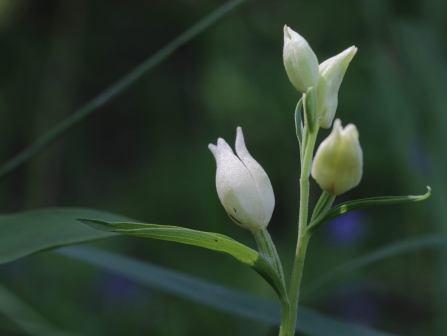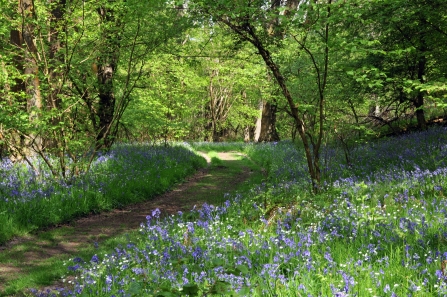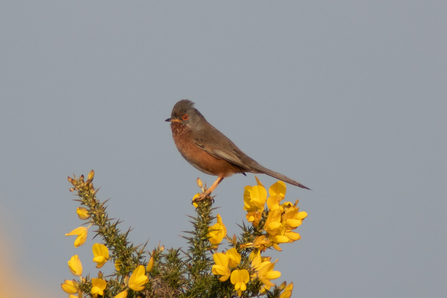
White helleborine. Photo by Bjorn S/Flickr.com
Skylark by Stefan Johansson

White helleborine. Photo by Bjorn S/Flickr.com
Tucked away on the edge of Wendover Woods between Aylesbury and Tring, Aston Clinton Ragpits is a remarkable nature reserve. Just three hectares in size and boasting eight species of orchid and over 25 different types of butterfly, this reserve offers a real treat to visitors in spring and summer.
Discover more about the reserve and its wildlife on a guided walk with Phil, the reserve's warden, on 25 May. Book via the link below.
Access: There is a network of smaller paths that visitors are free to explore. Short, steep slopes; some loose stone; steps.
Guided walk 25 May - Discover flowers and butterflies at Aston Clinton Ragpits

Bowdown Woods by Rob Appleby
Carpets of bluebells and other woodland flowers fill the woods here in May along with birdsong and trees bursting into leaf. The nature reserve has three areas to explore - Bowdown, Bomb Site and Baynes, all with a different character.
The Bomb Site is so named because it was an ammunition store during and after the Second World War. It is a great example of how nature can thrive and develop on a site vacated by people. Many old, surfaced tracks create a network through the young birch and oak woodland that has colonised the site. Try the short Wildlife Walk from the car park - it's on surfaced tracks and ideal for less mobile visitors.
Bowdown is magical, dense ancient woodland, which has views across the Kennet Valley. The 1-mile Wildlife Walk takes in some damp clay areas on the lower slopes and steep climbs up to higher, drier ground.
Finally, Baynes is the most secretive part of the wood. The dense ancient woodland here has lots of streams and some steep paths. The Wildlife Walk has some steep sections, steps and bridges.
You can explore the reserve and wider countryside around Bowdown Woods on our 6-mile circular walk.
Access: Variable, the reserve is made up of 3 areas:
Baynes: steep slopes, uneven underfoot, long flight of steps and a boardwalk.
Bomb Site: flat and surfaced, accessible for robust mobility scooters and robust wheelchairs.
Bowdown: gentle slopes, soft after rain.

Fly orchid. Photo by Mick Jones
In spring, there are carpets of bluebells in the woodlands. At the clearings and woodland edges, primroses and cowslips flourish. You can also find wood vetch here, the only place in Buckinghamshire where it grows.
In spring and summer, these sheltered sites encourage a range of butterflies such as dingy and grizzled skippers, chalkhill blue, silver-washed fritillary, marbled white and meadow brown.
Discover more about the reserve and the work to transform ex-arable fields into an exciting space for wildlife on our guided walk with Mick, the reserve's warden, on 26 May. Book via the link below.
Access: Variable, gentle slopes, bumpy in places; gates; benches.

Dartford warbler on a gorse bush. Photo taken by Steve Cottrell on Greenham Common
Greenham and Crookham Commons form the largest continuous tract of open heath in Berkshire. It is special for the mix of heathers, gorse, grassland and expanses of bare gravels - all easily accessible to visitors.
At this time of year it's important to keep to the paths to avoid disturbing ground-nesting birds, like nightjar, which breed here. Use the map to find the main paths and areas where you can exercise your dog off the lead.
Heathland habitat is ideal for certain species of birds because of its open nature, with just a few scattered trees and bushes for them to use as singing posts or look out points. It is also relatively warm and dry and has an abundant food source in the form of invertebrates. You may be lucky enough to hear the rich and varied song of a nightingale, or the warbling call of a skylark high in the sky, or see a Dartford warbler perched on the gorse.
Join the seasonal wardens for a guided walk around the reserve on 22 May and learn more about the wildlife that lives here. Book via the link below.
Access: The main tracks across the common are level and accessible for those with limited walking ability, off-road bicycles and off-road mobility scooters. Other waymarked routes are colour-coded and cross varying terrain.
Undulating wooded valleys with uneven terrain including steps. Most entrances have 1.5m bridle gates. Height barriers on minor car parks, main car park accessible to larger vehicles or those carrying cycles on the roof.

A couple walking through Warburg Nature Reserve. Picture: Ric Mellis
Nestled away in the Chilterns, not far from Henley-on-Thames, Warburg Nature Reserve is the perfect place to escape and explore. There's a mix of chalk grassland and woodland and through the year it's home to many different types of wild orchid. The early-purple orchids are flowering now, along with bluebells and other woodland flowers.
Out on the chalk grassland colourful wild flowers are starting to bloom, attracting a wide range of butterflies and insects, while red kites and buzzards fly high overhead.
Access: Variable, mostly steep paths and loose flint, flat grassy path; muddy in valley bottom after rain; benches.
A mobility Tramper vehicle may be available, email hughweldon@bbowt.org.uk or call 07541 690655 before visiting to book in advance.

Skylark by Stefan Johansson
Wells Farm is a working farm run in harmony with wildlife - home to farmland birds including corn bunting, yellowhammer and partridge.
The farm is named after the numerous springs emerging on the valley side. In the valley bottom, a wildflower meadow has been created, and a small tree-lined brook links two ponds, attracting a wide range of wildlife such as frogs, toads, chaffinches, coots and dragonflies.
Access: Gently sloping; soft in valley bottom, bridleway flat; kissing gates, boardwalk
